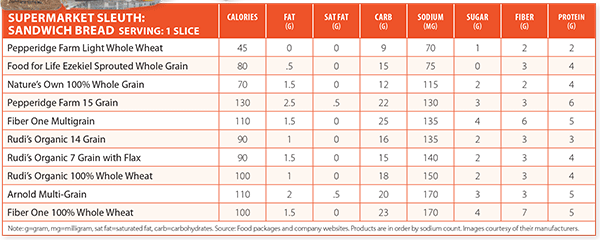Shopping for the Healthiest Sandwich Breads
People sometimes think they have to eliminate bread from their diet to eat healthfully or to lose weight. Bread is actually a good source of protein, calcium, iron, B vitamins, and fiber. But it also can be a source of many unhealthy ingredients, such as sugar, sodium, and preservatives.
Here’s how to find the healthiest bread when shopping.
Ezekiel Bread
Ezekiel bread is made of sprouted whole grains (grains that have begun to sprout or germinate), including wheat, barley, millet, lentils, and spelt. Named after a Christian Bible verse (Ezekiel 4:9) that instructs followers to combine these ingredients into bread, Ezekiel bread is robust in fiber and nutrients with no added sugar and minimal processing. Because it has no preservatives, it needs to be kept refrigerated or frozen. However, that gives it a “freshly baked” flavor, Lustgarten says.
Look for the word “whole.” When buying whole-wheat or whole-grain bread, “beware of buzzwords and manufacturer claims on the bread label,” says Rachel Lustgarten, a registered dietitian at Weill Cornell Medicine. Words like “wheat,” “whole grains” or “multigrain” don’t necessarily mean 100 percent whole grain. To guarantee a bread’s wholeness, “look for claims of 100 percent whole grain or 100 percent whole wheat on the front and for whole wheat to be the first ingredient on the ingredients list,” she says.
Look for the most dietary fiber. Whole-grain bread has the most dietary fiber—about 3 grams (g) per slice, compared with less than 1 g per slice for enriched white bread. The fiber you get from whole-grain bread offers a number of benefits. It slows down digestion, keeping you full longer and helping to balance your glucose and insulin. Fiber also helps your system consistently eliminate waste.
Look for the least sugar and sodium. “Sugar should be 3 to 4 grams maximum with no added high-fructose corn syrup,” says Lustgarten. Sodium should be less than 200 milligrams (mg) per slice. Sodium can really add up once you start building a sandwich (see article on healthy alternatives to cold cuts on page 1).
Beware of low-carb bread. When opting for a lower-carb bread, know what you are buying. “When people drastically decrease carbs, their diet is usually lacking in fiber and B vitamins,” Lustgarten explains. Low-carb breads often are highly processed with many chemical additives to make up for the missing grains. “Added fiber might be in the form of isolated fibers, such as inulin, and the benefits have not been well documented,” she says.
Control portions. Instead of using two slices of bread for your sandwich, try putting your food on one slice.
Note: Limiting your bread to one slice of whole grain is a healthier option than eating two slices of low-carb bread. You either can eat the sandwich open-faced (flat), or fold it in half for easy holding. Try pairing your half sandwich with a small salad, half-cup of low-sodium soup, or a piece of fruit.

The post Shopping for the Healthiest Sandwich Breads appeared first on University Health News.
Read Original Article: Shopping for the Healthiest Sandwich Breads »
Powered by WPeMatico

